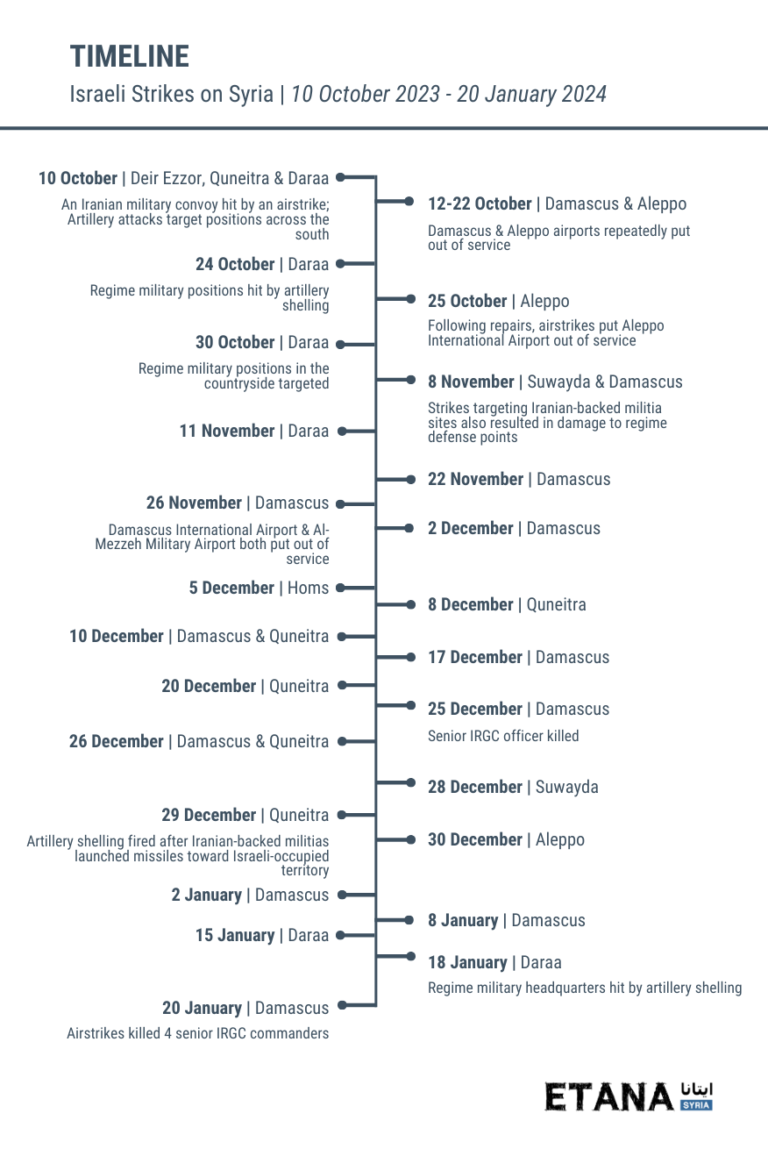Israel’s daytime airstrike that killed several senior Islamic Revolutionary Guards Corps (IRGC) commanders in western Damascus’ Al-Mezzeh district on 20th January is a reminder of the ongoing conflict-within-a-conflict between Iran and Israel in Syria. After more than three months since Hamas’ unprecedented 7th October attack on southern Israel and the beginning of Israel’s brutal campaign inside the Gaza Strip, Syria is still acting as an additional theatre for hostilities between Israel and Iranian-backed militias—including Lebanese Hezbollah.
According to ETANA monitoring, Israeli forces have carried out at least 45 attacks on Syrian territory since 10th October, mostly targeting Iranian-backed militias’ missile launch-sites and bases, as well as regime military sites across the south-west. Though Israel has for years carried out intermittent but persistent aerial attacks on Iranian infrastructure inside Syria—including weapons convoys, militia bases and individual commanders and their affiliates—there has been a notable increase in Israeli strikes on Syrian territory since October.
Large numbers of Iranian-backed reinforcements have deployed to the south in recent weeks, pointing to a high state of readiness and raising serious concerns about the potential for further escalation—including a possible broader regional conflagration that could include Israel, Lebanon, Syria and possibly other states in the region. In south Syria, Iranian-backed militias have repeatedly launched attacks toward Israel and the Israeli-occupied Golan Heights, mostly from southern Quneitra and south-west Daraa. Amid wider concerns of a new front against Israel opening, civilians living in the crossfire remain in danger so long as hostilities continue.
Attached Map:
Israeli Strikes on Syria
(For a high-resolution version of this map, please use the form at the bottom of the page)
7th October & Iran’s Response
Prior to 7th October, Hezbollah and a range of Iranian-backed groups were already deeply embedded along the border strip between Quneitra province and the occupied Golan. Hezbollah has always been the primary pro-regime militia force active in the area, engaging in intermittent exchanges of hostilities with Israeli forces. With renewed Iranian-backed military movements in the area, tensions are now higher than ever.
Though both Iran and Hezbollah’s leadership have denied any involvement in Hamas’ 7th October incursion into Israel, Tehran’s regional proxy forces have since stepped-up attacks against Israel. Although these actors’ precise motivations are not immediately clear, their attacks may intend to expend Israel’s resources and divert military units away from Gaza, while signaling that Iran intends to use the Syrian front in case of any wider regional conflagration between Israel, Hezbollah and Iran.
The most active front remains to the north, along the Israel-Lebanon border, where Israeli and Hezbollah forces regularly exchange blows. However, Iranian-backed militias are poised to act in south-west Syria as well. Large numbers of Iranian-backed fighters have been deployed to the south-west since October—predominately in southern Quneitra—with new reinforcements often bolstered by Iranian commanders from the IRGC.
Targets
In addition to tracking Iran’s movements, Israeli forces have targeted regime and Iranian-backed militia positions across the south-west. Quneitra province in particular has seen the largest build-up of Iranian-backed fighters, and militia sites there have been frequently targeted.
The targets of Israeli strikes have largely been missile launch-sites or regime military facilities deemed to be complicit in facilitating (or failing to curb) Iranian-backed militia activity. With no de-escalation in sight, however, Israel has shown it is increasingly willing to carry out targeted attacks on high-level Iranian and Hezbollah figures in Syria. Already, strikes in and around Damascus have resulted in the deaths of several high-ranking IRGC officials, including senior IRGC commander Reza Mousavi and high-level Quds Force intelligence official Hajj Sadiq. Israeli strikes have also repeatedly forced airports in both Damascus and Aleppo to temporarily close for repairs.
Messaging
While the crux of the Hezbollah-Israel front lies along Lebanon’s southern border with Israel, Hezbollah has a strong presence in south-west Syria that could transform into an open another front with Israel in case of a broader regional conflagration. The significant uptick in Israeli aggression in Syria is intended to constrain Iran’s military presence and activity in the south-west while punishing the regime for failing to rein-in Iranian militias active on Syrian territory.
For years, Damascus has allowed Iran and its proxies to build up their ground presence in south-west Syria after they provided critical ground forces, material support and intelligence backing that ultimately helped the regime survive more than a decade of conflict. Despite apparent pressure from Tel Aviv, Damascus has little to no power over Iranian activity in the south-west.
Humanitarian Impacts
Israeli strikes and the fear of further attacks prompted nearly 5,000 people living along the border strip with the occupied Golan to flee their homes in October. Following the seven-day ceasefire between Israel and Hamas the following month, many began to return. The increase in high-profile targeted killings inside Syria and Lebanon, however, represent significant escalations by Israel and indicate that further hostilities may be in the offing. Further hostilities could prompt more displacements away from the border strip in the coming weeks.







